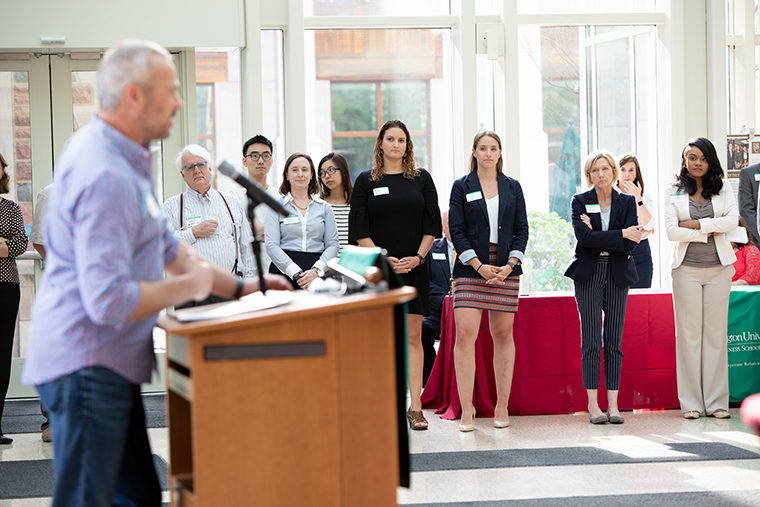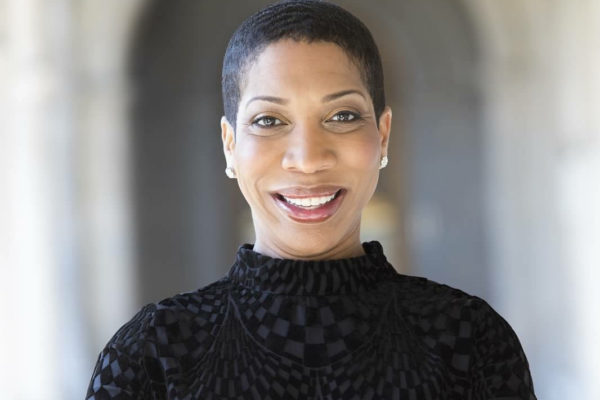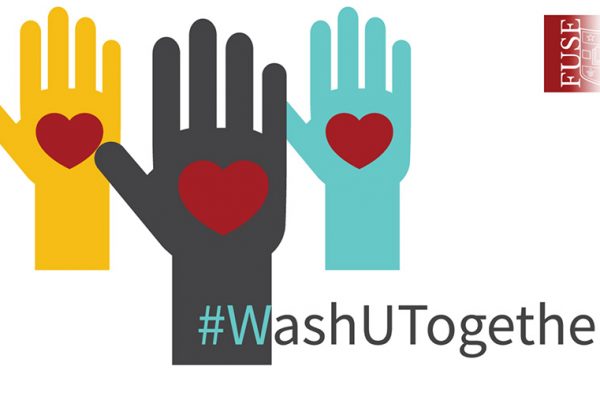The women of the MBA Class of 2017 went to the Olin Business School’s administrators, among them assistant dean Ruthie Pyles Stiffler, and asked: How can we help to attract even more women here? Then they got on the phones.
The Olin Women in Business club at Washington University in St. Louis launched a campaign to complement the work of the school’s admissions office, calling women accepted but undecided for the next incoming MBA class, to explain peer-to-peer why the school, program and opportunities are so accommodating for women. They networked. They recruited. They helped to create a bedrock, a foundation.
The composition of the current MBA class, due to graduate the two-year program in 2019, is 39 percent women. It marks the second of three consecutive classes to hover around 40 percent.
The phoning, the networking, the extolling of Olin’s virtues for women continues. Such a group effort is one thread weaved into the fabric of an Olin MBA program ranked No. 4 in the world for women, according to a Financial Times analysis released in March — placing it behind only Stanford and the University of California, Berkeley among U.S. universities, and China’s Shanghai Jiao Tong, but just ahead of Harvard.
“When I arrived at school, it was 40 percent women, one of the best in the country for the 2015 incoming class,” said Cassie Galante, a 2017 MBA graduate who came from the publishing business in New York in hopes of altering her career course, her life. Both ended up changing dramatically: Now she’s in Seattle working as a senior vendor manager for Amazon. “I think that’s a huge piece: We’re viewed as a school that’s a good experience for women.”
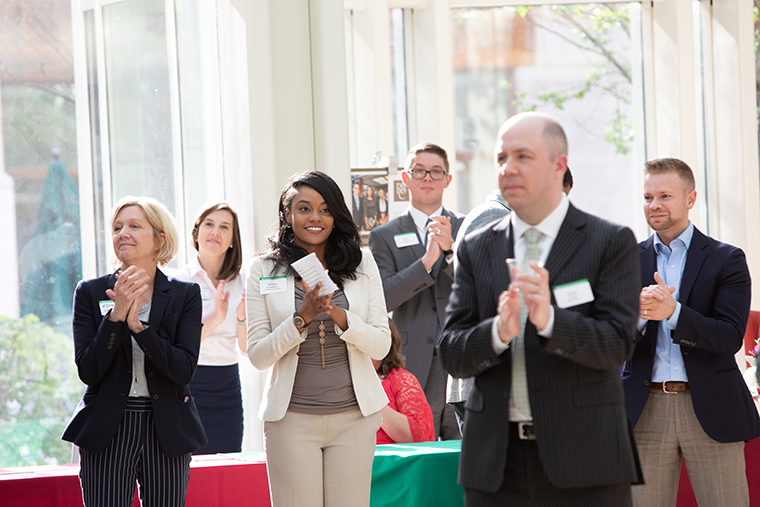
The idea started in 2016-17 with Marissa Burik, an admissions officer with the Olin Women in Business Club over which Galante was president. Burik, 29, a senior consultant with Navigant Consulting in Chicago, previously worked as a political consultant on campaigns and got them on the line. Galante said: “We called 100 to 200 women per phone bank. We tried to talk to everyone. If we couldn’t talk, we emailed. You can’t create a school that’s valuable for women without attracting women and letting them build something together, an environment that helps them learn and grow.”
This environment, quantified in the Financial Times statistical analysis, consists of several components: student body composition, faculty composition, gender equity, career placement and post-MBA salary, among others. And Olin’s administrators talk about how there is support at all levels to achieve equity in the program, from the dean’s office to faculty — where six of the seven new hires for this academic year were women — to staff to students, who were among the first U.S. business schools to form a Men As Allies club.
“It is critical for all of us to support women in business,” said Pyles Stiffler, who came to Olin in 2016 and serves as assistant dean and director of graduate programs admissions and financial aid. “At a meeting I had recently with Dean Mark Taylor, he said, ‘It’s my mission to get us to 50 percent women. That’s where we need to be. It’s not only where we want to be. It’s where we need to be as an international school and to be seen as a leader.’
“It’s a focused investment: to ensure that women who do come to Olin have very strong connections both inside and outside of the school — access to advanced resources, access to seminars — it’s a wonderful network of women all across the United States and with international partners as well.”
Global recruitment
One such partner is the Forté Foundation, an international nonprofit involving leading corporations and some 50 participating business schools. It helps to attract and connect women seeking MBAs with a program that seems like a good fit. Forté bestows membership upon all women MBA students in their participating schools and also provides a framework in which those schools select scholarship recipients each year, called Forté Fellows. Olin tries not only to maximize those prospects, but also to recruit minority students through a different nonprofit that Washington University helped to found in St. Louis more than a half-century ago called The Consortium.
“That was another focus of ours this year,” Pyles Stiffler said, referring to the program that connects both women and men students to its 19 participating MBA programs, extending scholarships as well.
‘It just comes down to the fact that Olin saw the value of having women in the class is not just for the statistic. There’s so much value to the diversity of opinion and viewpoint.’
Cassie Galante, MBA ’17
Both organizations offer a summer convention as well as programs throughout the academic year. Forté, for one, provides enough threads to weave a rope that women can grasp together.
Ashley Lautzenheiser, associate director of recruitment, remembered the Forté conference last summer stressing the lack of women in leadership roles as a whole: “ ‘So when you are there, what are you going to do?’ That really was the message,” Lautzenheiser said. “It isn’t about getting just one woman in the C-Suite. It’s awareness, it’s education and it’s going to become more institutionalized to carry forward to women in future generations. ‘How are you going to advocate and change and make it more of a level playing field?’ ”
The field also requires seeding up front — a grassroots effort of attracting more and more talented women as students. Recent alumnae such as Galante and current students remain vigilant in calling, emailing and continuing relationships with women who are potential students, as well as those currently enrolled in the program and those just starting their professional journeys.
Neelam Vyas was the outgoing president of the Graduate Business Student Association at Olin before graduating in May. She was part of the Class of 2018 — coming from Hendrix (Arkansas) College and working in healthcare in Dallas — when she and fellow women classmates realized the gender ratio of their class.
“When they sorted us out in core teams, we saw that difference in numbers can really make a difference in team dynamics, just bringing diversity of thought to group work and classes,” said Vyas, who is working an an internal consultant at Eli Lilly after graduating in May. “As a first-year officer last year, we joined the fight with Cassie and the others. Really, it was injecting the personal touch that made such an impact on us. I’m so proud our hard work paid off and our numbers went up this year.”
Clubs and community
Pyles Stiffler and Karen Heise, interim director of the Weston Career Center for the past two years and a fixture in the department for a decade and a half, noticed how women keep popping up as elected leaders of Olin’s clubs. There’s Vyas in the overall graduate-student body association, Perri Goldberg with Olin Women in Business (OWIB), entrepreneurship, consulting, you name it. Of 30 Olin clubs total, nine are run by women presidents. In Vyas’ GBSA, 43 percent of all elected officers are women.
“It’s really collaborative, really welcoming. Bringing in more women to the program and getting it closer to 50-50 was one of our OWIB goals,” said Goldberg, a New York University grad previously working in finance who, after MBA graduation, starts as a project manager at Regeneron Pharmaceuticals. “We can only close the gap if both men and women are involved. Women can’t do it by themselves. It starts with a discussion, and the discussion can start at Olin.”
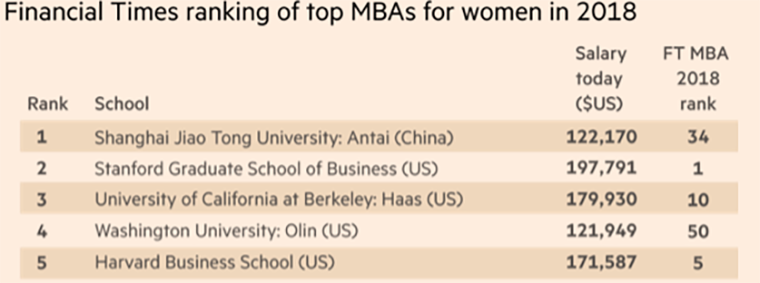
“One of the things our women students say, it’s really important that they have that voice in the classroom. That we have balanced teams. That the female voice is represented,” Heise added. “It’s not just important for the growth of women, but important for everybody in the classroom.”
By the way: In celebration of the Financial Times’ fourth-overall ranking, Heise and a student conceived and hatched a T-shirt: “Olin 4 Women.”
At Olin, students and club members connect with faculty, staff and administrators, but they craft ties and bonds far beyond the campus. There are women alums and women leaders from the St. Louis business community and elsewhere whom students meet, hear and get to know in presentations, special gatherings and trips abroad.
On International Women’s Day in March, for instance, Hillary Anger Elfenbein, the John K. Wallace Jr. and Ellen A. Wallace Distinguished Professor and professor of organizational behavior, led a Kansas City seminar for business women on the art of negotiation while, in a live-streamed event, four successful graduates of the Executive MBA program spoke at Emerson Auditorium in Knight Hall. The latter event allowed such leaders to discuss their ladders and ceilings — those issues facing them either, or both, as women and business people: having children, balancing work and family, health issues, competition, takeovers, succession or advancement within corporate or family-business structures, and so on.
“What I’ve heard professionals talk about is that women tend not to invest in building networks in the same way as some of our men counterparts do,” Pyles Stiffler said, referencing part of what students learn from interactions with women leaders in business. “Talking about it and demonstrating it, and why it matters, is important to hear – not just for our women students, but for women in the community.”
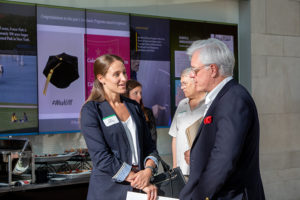
It’s part of what made the Olin environment “different from what I experienced in the business world, where often I was the only woman at the table,” Galante said. “I’m in a completely different world and role now. It comes down to seeing people who look like you doing things that you aspire to do. Without that, it’s hard to imagine yourself in those roles and put yourself out there.”
Career paths
The Financial Times data indicated that Olin ranked near, if not at, the top in starting salary increase for women (153 percent) and in a combined metric the outlet called pay-gap percentage (99 percent). While business schools parse statistics publicly by industry and degree, there are no reported real differences in numbers for women and men, Heise said.
“Generally, our employers don’t differentiate on salary between a man and a woman,” Heise said. But they do appreciate the multiplicity of candidates. “Our recruiters rely on us for diversity. And they define diversity broadly: women, men, ethnicities, different parts of the world, different backgrounds, different majors, different concentrations. So the more diverse we are, the better we are serving the employers in our market.”
The short form: More and more Olin women MBAs are doing increasingly better in starting average pay (all Olin MBAs had a $100,000 median base in 2016 and $108,000 in 2017); heading to the West Coast (where the median was $140,000 over 8 percent of the 2016 MBAs and $120,000 over 24 percent in 2017); and going into entrepreneurship anywhere. The St. Louis innovation ecosystem attracts a significant number of the women graduates, in particular.
Galante, part of that westward migration, is one recent example of how women MBA students grow and change at Olin. With a considerable boost from “Olin’s personal touch,” including, admittedly, owing to women faculty such as Catherine Dunkin, lecturer in business communications, she was able to reshape herself and go from a New York publishing behemoth to Seattle sales with the one and only Amazon.
“It just comes down to the fact that Olin saw that the value of having women in the class is not just for the statistic,” Galante said. “There’s so much value to the diversity of opinion and viewpoint.
“Olin really lives it; it’s a core belief of the school, like those banners hanging in the atrium. That’s why we’re near the top of the list. And why we’ll stay there.”
